 Last Updated February 9, 2025
Last Updated February 9, 2025
The most common Vitamix shopper’s question is some variant of, “I want to make smoothies, soups, and frozen desserts. Which Vitamix blender is best for me?” The answer is that all Vitamix machines work great for those tasks; which one is best depends on the volumes you want to blend and whether you want to pay for extra features.
If you don’t want to go through the nitty-gritty, here are my quick Vitamix recommendations:
Which is the best Vitamix model?
Best Value
- E310 (short/narrow container for small to medium amounts)
- Recon 5200 (tall/narrow container for small to large amounts)
- Recon E320 (short/wide container for medium to large amounts)
Money Is No Object
- Ascent X5 (latest and greatest)
The February 2025 shopping landscape
Most Vitamix models are on sale through Feb 22nd for the President’s Day Sale. Here is the sale.
Vitamix recently released a new set of Ascent models. Full details are in my Vitamix Ascent X Series Review.
The Food Processor Attachment gives more reason to consider Ascent and Venturist models, since it is not compatible with classic models. If you don’t care about the premium finish of the A3500, consider saving big on the Reconditioned Venturist.
If you are looking for the lowest possible price, I recommend choosing between the Recon 5200, the E310, and the Recon E320. The most significant difference between these models is the container they come with, so use the following Venn diagram to pick the optimal container for you. There are trade-offs between the three container options. To put it briefly, “short, narrow, or large capacity: pick 2”: 
Note to visitors from outside the United States: The model availability described on this page is for the USA (and APO/FPO addresses). If you are shopping from Canada, check out my page about Canadian Vitamix models.
For most people, I recommend choosing from the following four categories: Certified Reconditioned models, Explorian, Premium Classic, and Ascent.
Reconditioned
 If you are looking for the lowest possible price on Vitamix, reconditioned is for you. Some people are hesitant to buy reconditioned, and that is a valid concern with some companies, but Vitamix’s reconditioned units are guaranteed to be top quality. The only reasons I would avoid reconditioned Vitamix are if it is for a gift for someone who won’t understand, or if you want some of the features not available on reconditioned machines.
If you are looking for the lowest possible price on Vitamix, reconditioned is for you. Some people are hesitant to buy reconditioned, and that is a valid concern with some companies, but Vitamix’s reconditioned units are guaranteed to be top quality. The only reasons I would avoid reconditioned Vitamix are if it is for a gift for someone who won’t understand, or if you want some of the features not available on reconditioned machines.
Explorian
 If you prefer a slightly smaller container, I highly recommend the new E310, which comes with a short and narrow 48-oz container (full review). The Explorian E320 is functionally identical to the E310, but it comes with a wide container. That makes it nearly identical to the 5300. (The E320 replaces the 5300 in the model lineup, and it is mostly the same, with a few changes: it does not have the on-off switch on the side, and it does not light up when on. I don’t think these differences matter much, but there they are for anyone wondering about E320 vs. 5300.)
If you prefer a slightly smaller container, I highly recommend the new E310, which comes with a short and narrow 48-oz container (full review). The Explorian E320 is functionally identical to the E310, but it comes with a wide container. That makes it nearly identical to the 5300. (The E320 replaces the 5300 in the model lineup, and it is mostly the same, with a few changes: it does not have the on-off switch on the side, and it does not light up when on. I don’t think these differences matter much, but there they are for anyone wondering about E320 vs. 5300.)
There is now also an Explorian E520, which comes with the wide 64-oz container and adds 3 preset blending modes. With the hidden discount that gets activated after clicking a Vitamix link on this site and then adding the Recon E520 to your shopping cart, it is an excellent deal.
Premium Classic and Propel
If you want the most premium machine, but don’t want the new technology of Ascent, then the Professional Series 750 is for you. I think the Ascent machines are quite nice, but you might not like the look of their digital display, or you might want to be able to use older containers (without NFC chips).
In 2023 Vitamix released a new Series, which they are calling the Propel. Similar to the Pro 750, these machines have preset modes and a secondary on-off switch. The Propel machines also have the subtly updated styling that was released with the Explorian series: Propel 510 and Propel 750.
Ascent (Smart System Blenders)
If you want to buy into the future of Vitamix, the Ascent Series is the way to go. It’s priced in the same range as new Legacy models, but it comes with various upgrades (among them: longer warranty, timer display, can use small cups without bulky adapter, and a wireless connection to smartphone app).

 Within the Ascent Series, the A2300 is the lowest-priced model and it has everything you need. (If you’re buying reconditioned, the A2500 is the lowest-priced model, and it has all the features of the A2300, including full variable speed control, and it adds 3 preset program modes.) If you feel like upgrading, I recommend going all the way up to the A3500, because it has premium finish options. (I’m not saying that the intermediate Ascent models are a bad choice, they just wouldn’t be my choice.) See my Ascent review page for more details.
Within the Ascent Series, the A2300 is the lowest-priced model and it has everything you need. (If you’re buying reconditioned, the A2500 is the lowest-priced model, and it has all the features of the A2300, including full variable speed control, and it adds 3 preset program modes.) If you feel like upgrading, I recommend going all the way up to the A3500, because it has premium finish options. (I’m not saying that the intermediate Ascent models are a bad choice, they just wouldn’t be my choice.) See my Ascent review page for more details.
If you’ve been putting off getting a Vitamix because you’re saving up, you can get one right away with a payment plan. If you make on-time payments, there are zero financing fees.
You can leave a comment below or contact me if you are still having trouble deciding which one to get.
Comparison of pre-Ascent models follows
If you want to quickly see the relation between all of the different Vitamix models, you can jump ahead to my comparison chart.
I made an interactive tool to help explore the different features. Try playing with it to get a sense of which you are interested in. You can click any model to go to its Vitamix.com page, or you can read more about the different models below.
+ Show model selection tool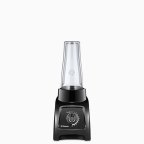 Recon S30
Recon S30  Recon 2-Speed
Recon 2-Speed  Recon 5200
Recon 5200  Recon 5300
Recon 5300  Recon Pro 500
Recon Pro 500 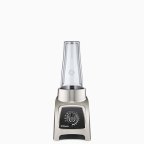 Recon S55
Recon S55  S30
S30  2-Speed
2-Speed 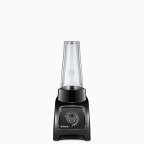 S50
S50  Recon 7500
Recon 7500  5200
5200  S55
S55 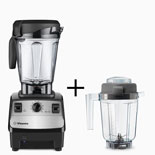 Recon 5300 + 32oz
Recon 5300 + 32oz  Recon Pro 750
Recon Pro 750  7500
7500  Pro 500
Pro 500  Recon 7500 + 32oz
Recon 7500 + 32oz  Pro 750
Pro 750 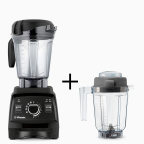 Recon Pro750+32oz
Recon Pro750+32oz  7500 + 32oz
7500 + 32oz  Pro 750 + 32oz
Pro 750 + 32oz  780
780 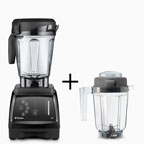 780 + 32oz
780 + 32oz(If you want the 32-oz container, you have to add it to your cart separately: 32-oz container link)
If you’re overwhelmed by the choices and just want to know my preference, I’ve used all of the different types of Vitamix blenders, and before I started using Ascent, the one I used on a daily basis was the 7500, with an extra 32-oz container for blending smaller amounts. (For the best deal, check out certified reconditioned.) All of the models are excellent, and I don’t think there is a wrong choice. (Plus, if you change your mind in the first 30 days, you can get a full refund, including free shipping both ways.)
Summary of Differences
These are the five key decisions to make when deciding which Vitamix to buy:
The following comparison chart shows the relations between the different machines in the S-Series, C-Series, and G-Series. The machines within most boxes of the chart are identical, but they come with different accessories and cookbooks (the exceptions are the S50 and S55, where the S55 has 2 more presets than the S50, and the Pro 750 and Vitamix 780, where the 780 has a flat touchpanel control). Generally the differences in accessories/cookbooks are pretty marginal, so I’d recommend going for the lowest price model within the box.

(“+” indicates there are also more expensive options in addition to the price listed in the chart. The following machines are not shown because they do not fit in with the rest: the Vitamix Turboblend Two Speed and Three Speed lack variable speed control, and the Vitamix 5300 and 6500 are a hybrid of the 6300 and 7500—i.e. they have a 7500 container on a 6300 base, without or with presets.)
Personal Blender? (S-Series vs. C-Series and G-Series)
(Vitamix S30 and S55 vs. 5200, 7500, et al.)
 In 2014 Vitamix released the Vitamix S30. It is smaller than the other Vitamix models, and also comes with a combination blending container/to-go smoothie cup. The Vitamix S50 and Vitamix S55 came out in 2015, and they are the same as the S30 but add preset modes. Since these models are significantly different from all the other models, I put up a detailed Vitamix S30 and S-Series review. If you are considering a smaller blender, or like the idea of blending in a to-go smoothie cup, you should check them out. Not surprisingly, the S-Series’ smaller size means that their maximum capacity is lower the other models (40 oz vs 64 oz).
In 2014 Vitamix released the Vitamix S30. It is smaller than the other Vitamix models, and also comes with a combination blending container/to-go smoothie cup. The Vitamix S50 and Vitamix S55 came out in 2015, and they are the same as the S30 but add preset modes. Since these models are significantly different from all the other models, I put up a detailed Vitamix S30 and S-Series review. If you are considering a smaller blender, or like the idea of blending in a to-go smoothie cup, you should check them out. Not surprisingly, the S-Series’ smaller size means that their maximum capacity is lower the other models (40 oz vs 64 oz).
Variable Speed?
(Vitamix Two Speed vs. 5200 and Vitamix 6000 vs. 6300)
 The variable speed control found on all Vitamix machines except for the Two Speed and 6000 is useful for when you don’t want to fully liquefy your blend. Examples are pesto, salsa, or chopping vegetables. If you don’t have variable speed, you can get away with quickly pulsing, but you won’t have quite as much control. The variable speed also makes the “bubble removal trick” more effective, although pulsing on low speed also works.
The variable speed control found on all Vitamix machines except for the Two Speed and 6000 is useful for when you don’t want to fully liquefy your blend. Examples are pesto, salsa, or chopping vegetables. If you don’t have variable speed, you can get away with quickly pulsing, but you won’t have quite as much control. The variable speed also makes the “bubble removal trick” more effective, although pulsing on low speed also works.
Preset Programs?
(Vitamix Two Speed vs. 6000, Vitamix 5200 vs. 6300, Vitamix Professional Series 200 vs. Professional Series 500, Vitamix S30 vs. S55, and Vitamix Professional Series 300 vs. Professional Series 750)
 The preset programs on the 6000, 6300/Pro 500, S55, and Pro 750 allow you to select a program, turn it on, and then the machine will automatically ramp up the speed and then shut off after a certain amount of time. There are a number of reasons that people appreciate this function:
The preset programs on the 6000, 6300/Pro 500, S55, and Pro 750 allow you to select a program, turn it on, and then the machine will automatically ramp up the speed and then shut off after a certain amount of time. There are a number of reasons that people appreciate this function:
• You can start the machine and “walk away” to do something else.
• If you strictly follow recipes the presets can yield more consistent results.
• Presets can give new users more confidence with the machine.
However, the presets do not work perfectly every time. Sometimes ingredients require tamping to start circulating past the blades, so you can’t always “walk away.” Also, the preset time might not be the optimum blending time if you modify a recipe. You may find that your smoothie is not fully blended after the smoothie program runs, so you have to run it again. A commercial coffee or smoothie shop makes the same recipes over and over, so in that setting presets are extremely useful. If you constantly make new combinations and of differing amounts, as many home users do, the settings may be less useful. It’s not too hard to tell when something is sufficiently blended, and after a few trials anyone should be able to figure it out. For these reasons, I personally would not pay extra for the preset settings. However, I know many people who have the presets love them. One thing to remember is that the machines with presets still have the variable speed knob for full manual control. If you don’t mind the added cost of presets, you can always switch back and forth to manual control.
C-Series vs. G-Series (Next Generation)?
(Vitamix 5200 vs. 7500, and Vitamix Professional Series 500 vs. Professional Series 750)
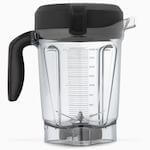 Vitamix released the “Next Generation,” aka “G-Series,” models in 2012. Both the base and the pitcher have an updated design. The base has slightly better sound muffling and also has better airflow which means that it can work harder before it overheats. To go with the better-cooled motor, the updated pitcher has a 4-inch blade instead of the Standard/Classic “C-Series” 3-inch blade. The 4-inch blade is in a shorter and wider container that has the same capacity as the 64-oz C-Series container.
Vitamix released the “Next Generation,” aka “G-Series,” models in 2012. Both the base and the pitcher have an updated design. The base has slightly better sound muffling and also has better airflow which means that it can work harder before it overheats. To go with the better-cooled motor, the updated pitcher has a 4-inch blade instead of the Standard/Classic “C-Series” 3-inch blade. The 4-inch blade is in a shorter and wider container that has the same capacity as the 64-oz C-Series container.
Advantages of the wider design:
• less need for the tamper (ingredients fall into the blades more easily)
• better chopping capability (you can course-chop more ingredients at a time)
• easier to scrape thick mixtures out
Advantage of shorter design:
• easier storage (at 17.5” tall, the container with lid on the base fits under standard kitchen cabinets)
Advantages of the 4-inch blade:
• faster processing time
• under some circumstances, marginally smoother blends
The one disadvantage of the new container is that for small volumes of under ~2 cups it does not work quite as well as the C-Series narrow container. The G-Series wider design causes two things to happen. First, there is more splashing up onto the inside of the lid and upper walls of the container, which means you lose a small amount of your blend unless you carefully scrape off the lid and walls. Second, you need slightly more volume to cover the blades and get good circulation going. The minimum volume to blend depends on what you are blending, and also on how much effort you are willing to spend pushing ingredients back into the blades. For example, for best results, the narrow containers can make nut butter easily by starting with 3 cups of nuts, whereas the wider Next Generation containers do best with 4 cups of nuts. For easier, more liquidy, blends, you can go below 1 cup in either container, but Next Generation containers will splash around more.
This disadvantage is a non-issue if most of your blends are over 2 cups, or if you are willing to spend a bit more to buy an additional narrow container, which will give you the best of both worlds. I like the 32-oz container for this purpose, although the 48-oz container has the same narrow bottom so it works just as well. The 48-oz container is just a bit bulkier on the outside because it sits outside the centering posts instead of inside of them, and its top is wider as well.
(The narrow C-Series Vitamix containers are compatible with G-Series models, but the G-Series containers are not recommended for use on C-Series models. The longer G-Series blades increase the load, and Vitamix does not recommend the C-Series cooling system for those increased loads.)
Reconditioned?
 Buying reconditioned is a great way to save money. For more details on deciding about buying reconditioned, see my refurbished Vitamix page.
Buying reconditioned is a great way to save money. For more details on deciding about buying reconditioned, see my refurbished Vitamix page.
Continue on for more details of each model type…
The array of different Vitamix blenders is a bit confusing, but it turns out that there is a lot of redundancy between the different models. I am only discussing models made for consumer/home use. Their commercial blenders are not ideal for home use because they are generally more expensive and have shorter warranties (3 years vs 7 years for home use; they are warrantied for constant use—think of how many times per day a blender at Jamba Juice runs compared to at your home).
The Vitamix website currently lists over 30 different home models, but they are all variants of three main designs: “personal” (S-Series), “standard/classic” (C-Series), and “next generation” (G-Series). For each of these main designs there are a few different options, to make a total of 8 different machine types. The rest of the models have identical bases, but come with different containers and/or accessories.
S-Series Motors
If the smaller size, dishwasher safe container, and “to-go” blending container appeal to you, please read the full details at my Vitamix S30, S50, and S55 review. For quick reference, the size of the base is 8.3″ deep x 5.9″ wide x 7.7″ tall. With the 20-oz to-go container the total height is 14.55″. The height is 15.66″ with the 40-oz container. These models have lower power, but they are still capable of making all of the usual Vitamix creations, just in smaller quantities.
C-Series Motors (Standard/Classic)
There are three types of bases of the standard variety. The differences are in the controls. The dimensions of the base of these machines are 8.75″ deep x 7.25″ wide x 8.25″ tall. There are three different container size options: 32 oz, 48 oz, and 64 oz, which result in height of base plus container/lid of 16.9″, 17.4″, and 20.5″ respectively.
Standard, no-variable speed (Vitamix TurboBlend Two Speed and Three Speed)
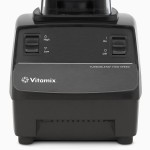 TurboBlend Two Speed (
TurboBlend Two Speed ($399$349); reconditioned for $299. This machine comes with a 5-year warranty and lacks the variable speed knob. Variable speed is useful for cases where you want to have finer control over the texture (i.e. if you don’t want a totally smooth purée). However, you can accomplish some non-liquefying chopping tasks by quickly pulsing the machine. While this is the most affordable new machine, I’d highly recommend looking at the reconditioned 5200, which has the same warranty and adds variable speed for $70 less.
In May 2016 Vitamix came out with a new no-variable speed machine, the TurboBlend Three Speed($499). It is exactly what it sounds like: it has three speed settings: low, medium, and high. It also has a pulse switch, which does the same thing as switching the start-stop button on and off. The pricing on this model is a bit strange, since for $50 less you can get a machine with fully variable speed. Plus, the TurboBlend 3-Speed comes with a 5-year warranty, instead of the 7 years on machines like the 5200.
Standard variable speed (Vitamix 5200 et al.)
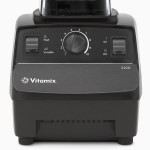 Until recently this was Vitamix’s bread and butter, and they have a lot of models to show for it: 5200 ($449), TurboBlend VS (retired), CIA Pro (retired), Pro 200 ($499), Creations II ($449), and Creations GC (retired); reconditioned for $329. These machines are essentially identical. Some are available with a shorter 48-oz container instead of the 64-oz container. The smaller container is nice because it’s more compact (and fits under standard kitchen cabinets), but of course its capacity is lower. The aesthetics of the switches and dial are slightly different between the different models. The Creations models come with a 5-year warranty, while the rest are 7 years. The 5200 comes with their “whole foods cookbook,” the TurboBlend VS comes with a vegetarian/vegan/raw cookbook and a nutmilk straining bag, the Pro models come with a cookbook with restaurant-oriented recipes (the CIA one—that’s Culinary Institute of America—comes with an additional recipe book). Note that if you buy reconditioned, you cannot choose which of the Standard models you are getting; Vitamix will choose for you based on availability, but remember that functionally they are identical.
Until recently this was Vitamix’s bread and butter, and they have a lot of models to show for it: 5200 ($449), TurboBlend VS (retired), CIA Pro (retired), Pro 200 ($499), Creations II ($449), and Creations GC (retired); reconditioned for $329. These machines are essentially identical. Some are available with a shorter 48-oz container instead of the 64-oz container. The smaller container is nice because it’s more compact (and fits under standard kitchen cabinets), but of course its capacity is lower. The aesthetics of the switches and dial are slightly different between the different models. The Creations models come with a 5-year warranty, while the rest are 7 years. The 5200 comes with their “whole foods cookbook,” the TurboBlend VS comes with a vegetarian/vegan/raw cookbook and a nutmilk straining bag, the Pro models come with a cookbook with restaurant-oriented recipes (the CIA one—that’s Culinary Institute of America—comes with an additional recipe book). Note that if you buy reconditioned, you cannot choose which of the Standard models you are getting; Vitamix will choose for you based on availability, but remember that functionally they are identical.
Sometimes these models are listed with their color-specific SKU. All of the following models are identical to the 5200, they just come with different colors and names: Vitamix 1709, 1363, 1364, 1365, 1709, 1723, 1732. They also sometimes go by VM0103. Vitamix 1978 is also the same, but comes with a 48-oz container.
Standard variable speed + presets (Vitamix 6300 and Professional Series 500)
 Pro 500 ($559) and 6300 (retired); reconditioned for $379. These are the same model; the only difference is that the 6300 comes with the “Savor” cookbook, which has a broader range of recipes than the Pro 500’s “Create” cookbook, which focuses more on restaurant-style recipes that tend to be richer.) They have 3 preset programs that run the blender for a certain amount of time and speed for smoothies, frozen desserts, and hot soups. Their switches are slightly different from the non-preset models. The non-preset models have an on-off switch, a variable speed knob, and a high-variable speed switch. The preset ones have moved the highest speed setting onto the knob and replaced the high-variable speed switch with a pulse switch. This is really a minor aesthetic difference, since you can achieve pulsing on the non-preset models by quickly flicking the on-off switch on and off.
Pro 500 ($559) and 6300 (retired); reconditioned for $379. These are the same model; the only difference is that the 6300 comes with the “Savor” cookbook, which has a broader range of recipes than the Pro 500’s “Create” cookbook, which focuses more on restaurant-style recipes that tend to be richer.) They have 3 preset programs that run the blender for a certain amount of time and speed for smoothies, frozen desserts, and hot soups. Their switches are slightly different from the non-preset models. The non-preset models have an on-off switch, a variable speed knob, and a high-variable speed switch. The preset ones have moved the highest speed setting onto the knob and replaced the high-variable speed switch with a pulse switch. This is really a minor aesthetic difference, since you can achieve pulsing on the non-preset models by quickly flicking the on-off switch on and off.
Some people love the presets because you can set it and walk away (assuming the mixture is circulating and you don’t need the tamper), and because they get more consistent results. However, the more consistent results will only hold if you always add the same quantities and types of items to the blender. For example, if you’re making a small smoothie, you can blend it for less time than if you were making a large one. One other thing is that you can set the non-preset machines and walk away—you just have to come back to stop them. I often use the blending time to rinse off the knife and cutting board that I used. You’re not likely to forget that the Vitamix is running because it’s loud enough to hear throughout the house. The variable speed knob goes to the same high speed as the previous models on high, but it’s lowest setting is a bit faster than on the 5200 et al., so you lose a tiny bit of fine control. Whether the presets are worth it is a personal question—I wouldn’t pay extra for them, but some people love them.
Standard no variable speed + presets (Vitamix 6000)
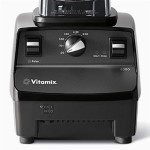 6000 (retired). Released October 2013, this is more of a mash-up of existing machines than a truly new one. It’s a sort of blend between the Two Speed, and the 6300. It does not have variable speed control, but it has six preset timed blending settings. These settings will automatically ramp up the speed, and then turn it off after a specified time of 20 sec, 30 sec, 1 min, 1.5 min, 4.5 min, or 6.5 min. Like the 6300, the pulse control is spring-loaded so that it only stays on as long as you hold it down, and it blends at a medium-low speed.
6000 (retired). Released October 2013, this is more of a mash-up of existing machines than a truly new one. It’s a sort of blend between the Two Speed, and the 6300. It does not have variable speed control, but it has six preset timed blending settings. These settings will automatically ramp up the speed, and then turn it off after a specified time of 20 sec, 30 sec, 1 min, 1.5 min, 4.5 min, or 6.5 min. Like the 6300, the pulse control is spring-loaded so that it only stays on as long as you hold it down, and it blends at a medium-low speed.
G-Series Motors (Next Generation)
In 2012 Vitamix released a new generation G-Series base with improved airflow that makes it run cooler and quieter than the classic C-Series one. With the improved cooling, the G-Series base can use a new pitcher design that is wider and has longer blades. This design makes the tamper less necessary, and makes it easier to get thick mixtures out. The longer blades also process food faster and work better for chopping. The G-Series machines are compatible with the C-Series containers, so if you want to use the dry blade you can use the same classic dry container. Dimensions are 9.4″ deep x 7.7″ wide x 17.5″ tall (with new-style 64-oz container in place). For more details of sizes, check out the PDF footprints I made for my Vitamix S30 review.
Next generation motor (Vitamix 7500, Professional Series 300, and Creations Elite)
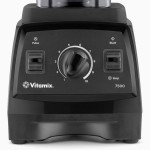 7500 ($529), Creations Elite ($557.50), and Pro 300 ($559); reconditioned for $439. These are all the same machine, so don’t worry about the note on the Reconditioned Next Gen page that says that the label may reflect any of these models. The only difference is the name printed on it. One point of confusion is that the Creations Elite is sold new with a smaller container, but if you happen to get sent a Creations Elite as a Reconditioned Next Gen, it will come with the same low profile 64-oz container that the 7500 comes with.
7500 ($529), Creations Elite ($557.50), and Pro 300 ($559); reconditioned for $439. These are all the same machine, so don’t worry about the note on the Reconditioned Next Gen page that says that the label may reflect any of these models. The only difference is the name printed on it. One point of confusion is that the Creations Elite is sold new with a smaller container, but if you happen to get sent a Creations Elite as a Reconditioned Next Gen, it will come with the same low profile 64-oz container that the 7500 comes with.
Next generation motor + presets (Vitamix Professional Series 750 and Vitamix 780)
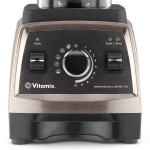
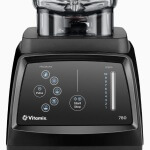 Pro 750 ($599–$649), 780 ($719); available reconditioned: 750 for
Pro 750 ($599–$649), 780 ($719); available reconditioned: 750 for $519–$569$499, and 780 for $519$399. These models have 5 presets: smoothies, frozen desserts, purées, hot soups, and self-washing. If you want to see more details of exactly what the presets do, check out my page about demystifying Vitamix presets. The 780 is identical, except that it has a touchpanel control interface. See my Vitamix 780 review for more details.
Vitamix Heritage 750 vs. Original 750?
In late 2015, Vitamix released a new version of the Pro 750: the Heritage line. The Vitamix Heritage 750 is functionally equivalent to the original Pro 750, but it has two differences on the exterior of the base. The upper shell (see diagram below) is now metal on the Heritage models. The Vitamix website doesn’t put Heritage in the model title, but it’s there in the description.
 The original 750 came in a brushed stainless finish option, but the upper shell was plastic with a thin metallic coat that could be scratched or scuffed. (When I tested the original 750 for a couple of months, I did not see any problems, but I have heard that some people have noticed scratches/scuffs.) The solid metal of the new Heritage models is more durable. Also, the metal shell muffles the the motor a bit more than the plastic, making the Heritage models a bit quieter.
The original 750 came in a brushed stainless finish option, but the upper shell was plastic with a thin metallic coat that could be scratched or scuffed. (When I tested the original 750 for a couple of months, I did not see any problems, but I have heard that some people have noticed scratches/scuffs.) The solid metal of the new Heritage models is more durable. Also, the metal shell muffles the the motor a bit more than the plastic, making the Heritage models a bit quieter.
 The other minor difference is that the Heritage models’ front panel has fewer backlights: Heritage models light up the indicators above the pulse and start-stop switches, whereas the original Pro 750 has backlights around the central knob as well.
The other minor difference is that the Heritage models’ front panel has fewer backlights: Heritage models light up the indicators above the pulse and start-stop switches, whereas the original Pro 750 has backlights around the central knob as well.
The Heritage metal is available in brushed stainless and copper finishes. (Currently on Vitamix.com, the Heritage options are listed on the main Pro 750 page, and the old brushed stainless finish is discontinued.)
I believe it is called Heritage because it is a throwback to the original Vitamix models that had all-metal bases. The plastic that Vitamix has been using for their bases for the past 25 years is extremely durable, so this change won’t affect functional longevity. That said, the elegant finish of the Heritage models will now likely stay unblemished for longer. It’s also nice that Vitamix did not increase the price for this upgrade.
The Vitamix 5300 and 6500
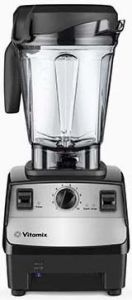 5300 ($529) and 6500 ($599); reconditioned for $360. Vitamix does not currently sell the new models online, only the reconditioned one. These are “new” models for 2015, although they are actually just slightly unexpected mash-ups of previous models. They are a hybrid between a 6300 and a 7500. They use the wide Next Gen (G-Series) container but they have a Classic (C-Series) base. The 5300 has variable speed and a pulse control switch, and has no presets. Meanwhile, the 6500 has the same three presets as the 6300. (Further evidence of equivalence between the 5300/6500 and C-Series models is on the Reconditioned C-Series 6300/Pro 500 page: it says its base may be a 6500.)
5300 ($529) and 6500 ($599); reconditioned for $360. Vitamix does not currently sell the new models online, only the reconditioned one. These are “new” models for 2015, although they are actually just slightly unexpected mash-ups of previous models. They are a hybrid between a 6300 and a 7500. They use the wide Next Gen (G-Series) container but they have a Classic (C-Series) base. The 5300 has variable speed and a pulse control switch, and has no presets. Meanwhile, the 6500 has the same three presets as the 6300. (Further evidence of equivalence between the 5300/6500 and C-Series models is on the Reconditioned C-Series 6300/Pro 500 page: it says its base may be a 6500.)
The reconditioned 5300 is the most affordable option for a machine with the short/wide container.
The strange thing about these models is that previously Vitamix stated that Next Gen containers should not be used on Classic bases because they do not have the updated airflow design that cools the motor more effectively.
I strongly suspect that the 5300 has the same microprocessor speed control as the 7500, Pro 750, and 6300, just without the presets. (You can read about the speed control of the different machines on my Vitamix RPM measurement page.) The microprocessor speed control should help protect the motor when using the wide container at high loads and very low speeds, but at maximum speed it shouldn’t make a difference. The marketing copy for the 5300 says that it comes “with a faster, yet quieter, motor,” but I am skeptical of those claims [Update: interestingly, Vitamix removed that phrase].
The 5300 and 6500 are a bit louder than the G-Series bases, which have sound-dampening technology not present in the C-Series bases. At the same price point, I would prefer the 7500.
Satisfaction Guarantee
Vitamix has a 30-day satisfaction guarantee, so if you have second thoughts you can return a machine within the first 30 days for a full refund and they even pay return shipping.
Warranty
If your machine has any problems during the warranty period of 5 or 7 years, Vitamix will repair or replace it, and they cover shipping costs both ways. For more details about warranties, check out my Vitamix Warranty page.
Reconditioned Vitamix
 I know I already mentioned reconditioned machines, but I want to restate what a great deal I think they are. These factory-refurbished machines offer the best prices you’ll find on Vitamix: 5200 for $329, Pro 500 for $379, and 7500 for $439. For more details, see my refurbished Vitamix page.
I know I already mentioned reconditioned machines, but I want to restate what a great deal I think they are. These factory-refurbished machines offer the best prices you’ll find on Vitamix: 5200 for $329, Pro 500 for $379, and 7500 for $439. For more details, see my refurbished Vitamix page.
Payment Plans
Want to start blending right away, but don’t want to pay the full price up front? Vitamix offers payment plans with zero interest and no fees if you make payments on time. For more information, check out my payment plan page.
Free Shipping
Clicking on any Vitamix link on this page will automatically apply a promotion code, which gives you free shipping on your order of a Vitamix machine (or anything else on Vitamix.com over $50) in the U.S. or Canada. For more details, see my page about the Vitamix promotion code.
Extra Bonus
If you order via a link on this site, Joy of Blending can get a commission. I deeply appreciate your support, and, to thank you, I want to help you get the most out of your new machine. I try to answer all questions from everyone, but sometimes I get swamped. If you order through one of my links, I will give you a private way to contact me so that I can answer your questions before visitors who are not on the special list. Please make sure my link is the last link you click before placing your Vitamix.com order. Then just forward your order confirmation to thanks@joyofblending.com.
Recommended Accessory
I highly recommend a spatula for getting the last bits of thick mixtures out of the container. For the narrow containers I recommend a long narrow spatula. For the wide containers, I recommend Vitamix’s under-blade scraper.
Dry Container
If you’re wondering if you should get a dry container, this new post is for you: Is the dry container worth it?
Phew… so that completes the Vitamix model round-up. I’m looking forward to getting back to describing some actual recipes!
Or follow along on Twitter or Facebook:

Hi Adam,
I live in Canada and was going to order a reconditioned 7500. I spoke with Barb Hezel @ Vitamix and she advised that they will not sell this model to Canadian customers.
I figured it won’t be a problem and advised that I’m planning on having it shipped to my US PO box and I’m buying with a US credit card (with US billing address).
She told me that if I bring it into Canada that the warranty would be void. I understand that the literature isn’t printed in French and that they want to protect the interests of their Canadian partners but this sounds pretty ridiculous to me!
Do you know why they are taking such a draconian stance on this?
Sorry, I don’t know anything about this. I only recently learned that Canadian Vitamix availability is different from in the US. I’ve since read about how Vitamix has different divisions for each country they sell in, and they take a hands-on approach for each country’s distribution. Part of that is presumably so that they can make sure they’re able to provide excellent support in each country, but I also suspect that it’s as you said—to protect interests of their overseas partners. For Canada I would think that NAFTA would mean that there aren’t tariffs, but for other countries tariffs are probably a factor, and there may also be different corporate tax rates. I could also imagine that their US operations are more streamlined/efficient, and it’s only worth it to them to sell to other countries at higher prices. I know it must be frustrating and I hope you can find something that works for you.
Hi Adam,
Thank you for having such a wonderful website. You have answered all my questions. I need your advice, If you have to choose b/w a vitamix blender and a juicer( omega vert 350HD), which one would you choose? The purpose will be to increase veg. and fruit consumption. Please help! Thanks!
Not Adam, but … I have both an Omega Vert HD and a Vitamix. Besides pure juicing, the Omega Vert makes a most marvelous strainer. The Vitamix does a marvelous job of chopping up nuts and stringy stuff like celery. Making an almond milk smoothie with dates and apples for example, I first blend them, then run it through the Vert. All three of those ingredients leave grainy, uncomfortable to swallow, bits even when heavily blended, but straining them in a fine mesh strainer or using cheesecloth is (very) time consuming somewhat messy process, but using the Omega Vert as a strainer is fast and easy and the mesh is far finer than any kitchen strainer you can buy. I used to make my nut milks ahead of time and store in the fridge for that reason, but now I just throw whatever in the blender, chop it up, and run through the Omega vert. I can toss in nuts, wheat or barley grass, celery or whatever into the blender, thru the Vert, fast, easy clean-up and extremely drinkable.
The thing is the Omega Vert will crush,juice and strain whatever is put into it and blender pre-processing doesn’t require Vitamix quality, whatever you have at present can likely provide a sufficiently chopped up mix that the Omega Vert can ‘digest’ it without a problem. Not to say a Vitamix wouldn’t be more optimum, releasing more of the nutrients, and it will handle ice better, and LOTS of ice is better, the cooler the mixture stays throughout, the more nutritious the end product.
The Omega Vert also provides for direct juicing without water, if that is a preference, including wheat grass, which a blender cannot do.
But I also use my blender alone for various tasks where a Vitamix is the bees knees, so I would certainly recommend both when it is affordable.
Thanks psoomah for the perspective from someone who has both. As you can see from the rest of this site, I’m clearly biased—I would definitely choose a blender. Ultimately, the difference between blending and juicing is whether you are removing the fiber or not, so the real question is do you want to remove the fiber? My understanding is that it’s healthier to consume the fiber than remove it (it’s more satiating and it helps spread out digestion, avoiding glucose spikes), though I’m sure juicing advocates would disagree. Other advantages of a blender: less waste/more bang for your buck on produce since you’re not throwing away all the fiber (and juicers will leave behind some nutrients in the fiber as well), and blenders are also generally easier to clean—the Vitamix pitcher is a single piece that you rinse, run with soapy water, and then rinse again and you’re done. A Vitamix will also allow you to make a variety other foods as well. And if you sometimes want a juice, you can use a sieve,straining cloth, or nutmilk bag to filter the fiber out of a total juice. There are plenty of people who have both a juicer and a blender, but I’m happy just having a powerful blender.
Regarding psoomah’s point of apples and celery, I really don’t have a problem with the texture of them in the Vitamix. I use apples in fruit smoothies a lot, and I use celery in savory blends, and I think they come out quite smooth. I also drink almond milk without straining it. I would say the almond milk is the one where the texture is most noticeable, but it does not bother me (lots of people choose to strain it though).
Thank you so much, Adam. I agree, the vitamix is a wise choice. Thank you!
Hi Adam,
Can the 32oz dry container be used as an extra container for making a smoothie( under 2 cups)?
This is an interesting question that unfortunately I do not have a full answer for. Vitamix’s line is that the dry blade does not work well for wet ingredients, but I haven’t really tested it myself. My guess is that it would work fine for liquidy things (like emulsifying a salad dressing or a thin smoothie), but that it would not work so well for an extremely thick smoothie. At some point I’ll try to run some tests, but I don’t know when I’ll get a chance. Conversely, Vitamix says that the wet blade is OK for dry ingredients; I tested it and was surprised with how well it worked.
Thank you,Adam!
Sable … I have that exact juicer on my kitchen counter 24/7. That’s how much I use it. The VitaMix is standing beside it. The Omega Vert 350 is an outstanding auger juicer and you can easily adjust how much pulp you need/want or even take some out of the extraction bin and add to the juice if desired. It’s a superb juicer. I make veggie drinks using both but the Vitamix but use the VM more for the things a juicer isn’t designed to do. In terms of quality of results, both are equal as I’ve seen … its all in how much you want to use the product beyond juicing. Both are staples in my kitchen. Hope this helps.
Thanks for the info, Barb!
The reason I use the Omega Vert Juicer in addition to the Vitamix is because I’m a senior and take a strong probiotic daily and use the Omega green juice for instant nutrient digestion and absorption into my system when I can’t manage all the fibre. My juices are 3/4 veggies and only 1/4 fruit so not meant to be a smoothie. I don’t use the Vitamix for juicing as much because they tend to be more frothy than I like. I want the juice and not the consistency of a smoothie for these particular drinks. It makes a difference. I honestly don’t know what I’d without these two workhorses in my kitchen. I just ordered the dry grain container because I’m getting into the flour thing for freshness and some grindings that will let me use my dehydrator for making crackers, etc. out of seeds rather than just flours.
Thank you so much, Barb. I really appreciate all the information you’ve shared with me. Thanks.
I just wanted to say thanks for writing this review. I ‘test drove’ a 5200 equivalent from BB&B, and it was fantastic, but I wanted something that would fit under my cabinets. The clarification you gave about the differences between the bases of the models I was looking (none, except preset functions) at was invaluable. Also, I really appreciated that you pointed out the differences between the old and new 68 oz wet containers, besides the obvious height/width change.
Just an all around great review. Thanks for taking the time.
Hi Adam,
What a helpful explanation of the differences between the Vitamix models. This will be my first Vitamix and I’m torn between the Pro750 and the 5200 Deluxe Complete Kitchen. The 5200 Deluxe includes 3 containers- 64 oz and 32 oz wet and 32 oz dry. Would you recommend spending the money on the next generation body of the 750 or on getting the extra containers with the 5200 deluxe? I’m not sure yet if I’ll need a dry container and also not sure of the quantities of wet ingredients I’ll be blending. We’re a family of 3 and I’m initially interested in making smoothies and frozen desserts/ drinks. Thanks for any direction you can provide on making this decision.
Sorry, I don’t have any additional advice to offer. They’re both great blenders that will be able to handle just about anything you throw at them. Personally, I like the value of the reconditioned Next Generation machine for $399. For someone who is not sure if they will use the smaller container or the dry container, it may be worth waiting to see if you really have a use for them.
Thanks for the suggestion- I’ll consider the reconditioned Next Generation as well. That would give me the option to add an extra container if I want to later and still not exceed the $649 I’m willing to spend. And if I don’t need the extra container, it is just a savings! So thanks.
Hi Adam,
What is the equivalent to the Vita Mix model 1364 CIA which is offered at Bed Bath and Beyond stores? Is it the 7500(Pro Series 300 or the 6300 (Pro Series 500)? Or some other model?
Thank you.
That model is the model I refer to as the CIA Pro in my post—it is the same as the 5200 et al. (standard, no presets). The only difference between it and the 5200 is the cookbooks it comes with.
You may be wondering, what is the 1364 number? Each Vitamix model and color combination is assigned a four-digit number, and they are not necessarily in any intelligible order. (The color numbers for the CIA Pro you mentioned are 1363, 1364, 1365, and 1709.)
Thank you so much for the comparisons. I don’t know if Vitamix understands just how complicated their website can be given that most machines are exactly the same motor but just marketed with different containers/cookbooks. Whew. I just ordered a Next Gen reconditioned model but I thought I’d pass on something the sales rep told me about the cookbooks in case it would be useful to someone else. The Next Gen machine comes with a cookbook entitled “Simply Fresh” and when I asked about buying the raw/vegan/vegetarian cookbook as well, she said it’d be best for me to wait until I got used to the new, wider container and blade setup first. Evidently the new container design blending times are different from those that are in the cookbooks designed for the standard model containers. I can’t see that the difference would be that great but, I’ll just see what’s what before I spend any more money. I hope this helps someone who might be thinking along the same lines.
Barbara, this helped me since I’ve been wanting the Veg cookbook as well and am planning to buy the Pro 750. I couldn’t understand why that cookbook wasn’t recommended for the 750 and probably would have bought it if I hadn’t read your comment. Thank you.
Do you have any idea why Consumer Reports would rate the 5200 higher than the 750 / 7500? It gave the 5200 a 91 out of 100 but the others 81 out of 100…
I do not know, but I have some guesses. I’ve only seen the print version of that article; I’m not sure if the online members-only section of Consumer Reports gives more details on their Vitamix Professional 750 rating. (If anyone has online access and if there’s any additional information about their rating of the 750, I’d be curious to hear.) The print version ranks the 750 slightly lower on two factors: icy drinks/smoothies and convenience. My speculation is that the icy drinks ranked lower because they were using a lower volume that the wider container doesn’t do quite as well with (unfortunately they do not say how much they blended, so we can’t be sure). Their convenience rating is based on “ease of cleaning, clarity of controls and jar markings, pouring ease, and jar balance.” I’m guessing that they either didn’t like the jar markings (which do not indicate the cup increments quite as clearly as the tall containers) or they didn’t like the pourability, which is a complaint I’ve heard occasionally, but that I do not think is a big deal for most people.
They also ranked the Ninja very highly, which I think is because their tests were designed to test standard blenders, not high-powered ones, so they didn’t fully put the Vitamix blenders through their paces. Specifically, I suspect that a) their durability test wasn’t enough to really tax the machines, and b) they were not blending the more challenging things that Vitamix blenders excel at. Their smoothie test was a pina colada that didn’t have seriously fibrous things like carrot, apple, or kale, they didn’t make frozen desserts or nut butter, and they didn’t include ability to heat in their rankings—they do actually mention that only Vitamix and Blendtec models were capable of heating.
We are subscribers to Consumer Reports, and I tried to figure this out. They don’t really give any more explanation for their lower rating of the 750 than what Adam surmised. Since the lower rating was for convenience, I too figured it was because of the way measurements are marked on the container and the shape of the pouring spout. At this point, I’ve read tons of user reviews which are 99% positive. They are actually what swayed me from going with the 5200 to save money and deciding to get the 750 instead. There are some great You Tube videos by a Henry PJ that also influenced my decision. He does not work for VM and is not an affiliate (he should be). He shows exactly what the 750 can do and puts it up against a Blendtec in one video. He loves his VM but does remark on the markings and spout as flaws in design. Overall, however, he has a very high opinion of the machine.
I’m excited to report that I ordered my Pro 750 today. Barb, the salesperson Adam recommended, was very kind and helpful. When I asked her about the Live Fresh cookbook, she said it would be fine to use with a smaller container (apparently the amounts for many of the recipes are not suited to the 64 oz wider container. I forgot to ask her about the Consumer Reports issue. I was too nervous about spending so much money on a kitchen appliance. But I’m looking at it as an investment in my health and an opportunity to take my dietary choice of plant-based nutrition to a higher level. Now I wait… Up to 3 weeks before it arrives.
Congratulations on making your decision and getting your order in! Thanks for the update. It sounds like you made a great choice!
Thank you Adam for helping me to decide on a Vita-Mix Blender. I was looking on purchasing a vintage V-M blender, but decided on the refurbished 7500. I ordered it yesterday. Now the only problem is waiting for it to arrive. Sales person said a week and a half ! Thanks again.
Thanks for your detailed post. I have an aged Vita Prep that I inherited from a brother in the industry and I’m going to take advantage of the trade-in program (yay!) and pick up a reconditioned next gen. With the trade in program, I’ll stick with the standard warranty and revisit the trade in should I want or need something new in 2018. 🙂 Cheers!
The Vitamix trade-in program is awesome, but I’m afraid it might not work for your blender. The Vita Prep is from their commercial line, and I think it might not be eligible. It’s worth a try though—you should call them and ask.
It is eligible. I called a few weeks back, to check on authorized repairs/warranties etc. and the salesperson mentioned the trade-in program as my best option at this point given the age of my Vita Prep. I just had to decide which machine to go with and it includes the reconditioned machines, so even better for me 🙂
That’s great to hear. Thanks for letting us know!
Hi, I wanted to bring to your attention that your measurements of the blenders up top seem to be incorrect. For example, the 750 and 7500 are 17.4″ tall with the container in place. Your graph shows under 17″. Not to be nitpicky but when I saw your chart I found it helpful until I verified it on the Vitamix website.
The line that the 750 and 7500 are under is the 18″ line (in between the 16 and 20″ lines). Upon closer examination of my graphic I see that the lines appear to not be perfectly evenly spaced, so I’ll have to fix that, but I still think that the heights of the machines are approximately accurate. By nature the graphic is a rough approximation, since there’s some perspective in the photographs of the machines. I also mention their actual heights in the post.
edit: I fixed the spacing of the lines.
Thanks so much for this blog; it’s been really helpful in narrowing the choices to three finalists! I’m hoping you can help with the final choice. I just lucked into a good annual bonus, and I can technically afford the new Pro 750 model if I wanted to blow the whole thing on a Vitamix. I hate to admit it, but I love bells and whistles. Second option is a split – either a refurbished next gen or a refurbished programmed one. Neither will fit under my cabinets, so that’s a toss-up, and would love your opinion on that also. Third option is a 5200 super package I found on an auction site, new, for $434! Awfully good deal, but I’m always wary of auction sites other than eBay, and not sure about the warranty, etc. Could you speak to these three (okay, four) options? I will primarily be making smoothies, nut butters, frozen desserts and general food prep (assuming I can just do some chopping to then throw in the skillet). Thanks so much!
Any Vitamix should work great for the tasks you mention, though in terms of food prep/chopping the wider (next gen) containers will work better. After that, it comes to questions of convenience: the wider container makes it easier to get stuff out and needs the tamper less; presets allow you to not have to think about how long to blend for. You say you love bells and whistles, so if you can afford it, it sounds like you’d be happy with the Pro 750.
Hi,
What a wonderful information. Thank you. After reading your posts and most comments, I think we will go for the 5200 model, since I do not care too much for the presets vs. the price increase to 6300.
One question though. I do not need the dry one, but was wondering if the smaller wet jar would be better for making coconut butter and nuts butters. (Would it be easier to get things out from the bottom than from the tall 64oz jar?) I am wondering if it is worth investing the extra $ for the small wet jar. (I do not think that the compact 64oz jar for next gen models would help me, since I will be making smaller quantities). Thank you so much again.
The shorter 32-oz jar does make getting nut butters out of the jar a bit easier because you’re that much closer to the bottom of the container. Also, if you’re making 4 cups or less, it’s slightly more convenient to handle the container (in terms of holding, pouring, rinsing, etc.). So it does add some value; whether it’s worth the cost is up to you.
I would also think that the new Next Gen 64oz container base and blade design with the wider area would make getting out nut butters much better than the standard container shape. I hesitated to make things like the nut butters because of how difficult it was to get the finished product out. My Next Gen hasn’t come yet but the pictures at Vitamix show a more open area around the blades which look as if getting a narrow rubber spatula around the bottom much more convenient. That was my main purpose for choosing the Nex Gen … that new container design should work better for many of the things I make.
Great site, thanks for all the info!
I think I’m looking at the “Reconditioned Next Generation” plus both versions of the 32 oz jar, which all together costs just a bit more than the 5200 Deluxe.
One question though…. A big part of my purpose behind the 32 oz. wet jar is to make mayo, which I make with just one cup of oil at a time as we don’t go through lots of mayo. But I’m really concerned about the Vitamix’s potential to heat foods. I know that’s a function of the high RPMs, but I look at that as one of few downsides of the Vitamix. When I make soup I prefer to cook it on the stovetop and then put it in the blender…I can’t imagine “cooking” it in the blender, but at least with soup the heat won’t damage it. Anyway, can the heating of cold (but not frozen) or room temp things be avoided by running the blender on a lower setting? If so, will things like pesto still blend at a lower setting? The idea of things like mayo or pesto getting even a little bit warm doesn’t seem good.
Advice would be appreciated! Thanks again!
Great question. Heating in the Vitamix is only significant at top speed and for extended blending times. The soups that are “cooked” in the blender are done at top speed for 4-6 minutes.
The variable speed control makes it easy to blend at lower speeds. I haven’t made mayo myself, but I know it’s possible with a Vitamix.
I enjoy making pesto in my Vitamix. When I make it I don’t blend it for very long and I use medium speed—mostly because it’s nice to retain some texture, and delicate basil flavor is sensitive to over-blending. I’ve never had it heat up, although there was a time when I slightly over blended it (made it too smooth).
The only time heating is an issue is when you start with room temperature ingredients that you want to blend for a long time. For example, if you want to make a smooth smoothie using fibrous ingredients like kale or carrots you’ll want to blend it for a while, which is why I always add ice or frozen fruit to something like that. Another situation is when I’m grinding whole grains, and want to get a fine flour. In that case I store the grains in the freezer so that they start out cold and then they don’t reach as high a temperature in the blender.
Great info! Thanks again!
thanks so much for your blog. I never would have purchased a Vitamix without your insights. Their web site is ridiculously confusing, insinuating that there are all these different machines, when in fact there aren’t. I just purchased a re-conditioned 7500 using your promo code
Rich … it was wonderful to read that I wasn’t the only person who found it difficult to slog through the different models outside of the obvious differences in dials, container size, addition of stainless design in base. I even opened several browser windows to do a careful comparison and when I couldn’t see the rationale behind the price variances (other than cookbooks, etc.) I finally phoned them and just came straight out and asked them. I bought a reconditioned NextGen eventually but the woman I had told me the machines were identical inside and were just marketed differently. I wonder if they realize how many people they turn off with this obfuscation. Such a wonderful piece of equipment deserves more than this. Glad to see I’m not alone.
Thanks so much for the great info. Ordered through your link. Love the free shipping!
Adam, thank you for all the information on the Vitamix, but I am still confused as to which one to buy. My doctor suggested that I buy Dr. Fuhrman’s book “Eat to Live”, and add more high nutrient foods to my diet. Dr. Fuhrman also suggest the purchase of a Vitamix. I am familiar with these machines, as I have purchased the Creation GC model 64 ounce container on QVC 2 yrs. ago as a TSV on EasyPay for my oldest son. I also purchased the Vitamix 7500 model 64 ounce container on QVC last Christmas as a TSV on EasyPay, which included 2 smoothie travel bottles, a Simply Fresh Cookbook, a 101 Blender Drinks book, and a Get Started DVD for my youngest son.
Adam, can you tell me if my son can use any of the 32 and 48 ounce containers on the Creations GC model?
Now, QVC will have a Vitamix Creations Elite 48 ounce container with variable speed, which includes tamper, Getting Started DVD, Vitamix Creations Cookbook and a 15-oz stainless steel travel mug as a TSV (Today’s Special Value). I have a question on the handle of the container. Why is the handle made of the same material as the container on this particular model? This model also comes in 6 diffferent colors, and only a 5 year warranty. Can you give me your opinion on this model. Thank you!
The 32-oz and 48-oz containers are compatible with all Vitamix machines.
The Creations Elite is a next generation base with a 3-inch blade 48-oz container. I think it’s a slightly weird choice, because the main advantage I see of the next generation machines is the new wider 64-oz container with 4-inch blade. If you’re looking to save money, I don’t think you can beat the reconditioned next generation model direct from Vitamix, which also comes with a 5 year warranty.
Adam, I thought you said that the new containers would not fit on the older models? Are you talking about the 64 ounce containers that would not fit on the Creations GC? I’m still a little confused! Thank you for your suggestion on buying a reconditioned next generation model directly from Vitamix. I will keep that in mind when deciding, which will take me forever!
To clarify, when I said “new containers” I was referring to the shorter, wider, 64-oz containers that come with the Pro 750 and 7500. (Note that there are two kinds of 64-oz containers: the classic tall ones, and the new short/wide ones.) The older machines are not optimized for use with the longer 4-inch blade in the wider containers.
The 32-oz and 48-oz containers use the same 3-inch blades as the tall 64-oz containers, and are compatible with all machines.
That explains it!! Thank you for simplifying this for me. You are very helpful! Thank you so much!
We are in uk. Only three models available here that i have seen, aspire, tnc (same as 5200 i think) and pro 500. I do lots of cooking but have limited budget. I think I can get away without presets and therefore save money for soups and smoothies but am concerned as to how to judge the timing for ice cream. Are the presets on 500 just time based or is there any sensitivity to quantity you are blending as we have 7 children and sometimes do smoothies for 2, sometimes 9?
Yeah, the Pro 500 does not have a way to sense quantity, so the preset programs always run for the same amount of time. That’s the main reason why I think they are of limited value.
The Pro 750 can reportedly sense the blade resistance and adjust its speed, although even it still would not be able to tell how much is in the container.
Hi penny. Am in the UK also. Did you buy a Vitamix eventually, and if so, which one/how you getting on with it? Regards
I’ve been going through the vegetarian recipes on the Vitamix site, all of which are written for use with the 5200 and say you will need to adjust for use with other machines. I am waiting to receive the Pro 750. Will I be able to simply use the variable setting dial instead of the presets and just disregard the “switch to high” instruction? Any other adjustments that may be needed?
Yes, for most things you would just disregard the “switch to high”, since high on the 750 is just speed 10. You may also find that things don’t need to be blended for quite as long. For recipes that are not blended at max speed, the conversion will require a little more finesse. I would recommend trying a few of the recipes from the cookbook that comes with the 750 to get the hang of it. I don’t know of any resource that has a table of equivalent speeds, so you’ll just have to play it by ear. Any recipe should be fully convertible, with the possible exception of low volume ones (under 2 cups), but if I remember right you said that you ordered the extra 32-oz container so you should have that covered.
Barb Hezel advised me to get the 48 oz wet container instead of the 32, as she thought that would allow me to make the smaller volume recipes but still have versatility. Are you saying that the speeds on the 750 are different than the speeds on the other models? Is that because of the different motors?
Yes, the combination of the different motor and control interface means that the speeds are slightly different.
The 48-oz container is indeed more versatile than the 32-oz, but my opinion is that if you have a 64-oz container available, you would use that for recipes that were too large to fit in the 32-oz. But again, here it really just comes to personal preference.